Linux学习第26节,内核中的“中断”下半部工作队列机制
发表于: 2019-02-21 20:31:07 | 已被阅读: 747 | 分类于: Linux笔记
第24节提到,在处理中断时,Linux 内核为了解决“又想做得快,又想做得多”的矛盾,将一次完整的中断处理分为“上半部”和“下半部”两部分,耗时较多但是对实时性要求不高的处理统统放入下半部。

Linux 内核中的工作队列
那如果想把下半部的工作推后到进程上下文中完成,或者推后执行的任务需要睡眠时,就需要借助
工作队列子系统其实算是一组接口,通过它创建的进程(即所谓的工作者线程)负责执行Linux内核或者其他模块排到工作队列中的任务。Linux 内核提供默认的工作者线程(event/n,n是处理器编号)处理队列中的任务,这样看来,工作队列就变成了一组把延后执行的任务(排入队列中的任务)交给特定线程(默认的工作者线程)处理的接口。
Linux 内核中工作队列使用的数据结构是 workqueue_struct 结构体,它的C语言代码如下,请看:
struct workqueue_struct {
struct cpu_workqueue_struct *cpu_wq;
struct list_head list;
const char *name;
int singlethread;
int freezeable; /* Freeze threads during suspend */
#ifdef CONFIG_LOCKDEP
struct lockdep_map lockdep_map;
#endif
};

struct cpu_workqueue_struct {
spinlock_t lock;
struct list_head worklist;
wait_queue_head_t more_work;
struct work_struct *current_work;
struct workqueue_struct *wq;
struct task_struct *thread;
int run_depth; /* Detect run_workqueue() recursion depth */
} ____cacheline_aligned;
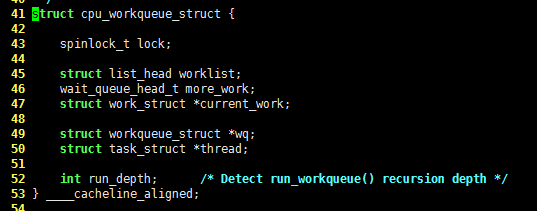
处理工作队列中的任务
结构体 cpu_workqueue_struct 的成员 current_work 表示工作者线程要处理的工作,它的数据结构由结构体 work_struct 定义,C语言代码如下,请看:
struct work_struct {
atomic_long_t data;
struct list_head entry;
work_func_t func;
};
成员 func 指向处理函数,data 则是它的参数。这些结构被连接成链表,每个处理器上的每种类型的队列都对应这样一个链表,例如前面提到的“默认的工作者线程”就有这样的链表。

299 static int worker_thread(void *__cwq)
- 300 {
...
|- 309 for (;;) {
|| 310 prepare_to_wait(&cwq->more_work, &wait, TASK_INTERRUPTIBLE);
|| 311 if (!freezing(current) &&
|| 312 !kthread_should_stop() &&
|| 313 list_empty(&cwq->worklist))
|| 314 schedule();
|| 315 finish_wait(&cwq->more_work, &wait);
|| 316
|| 317 try_to_freeze();
|| 318
|| 319 if (kthread_should_stop())
|| 320 break;
|| 321
|| 322 run_workqueue(cwq);
|| 323 }
| 324
| 325 return 0;
| 326 }
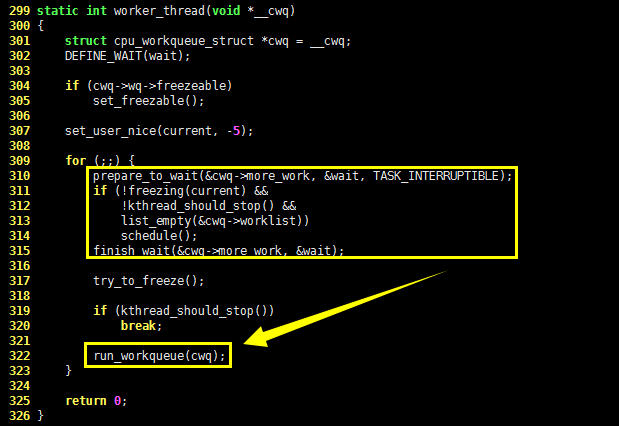
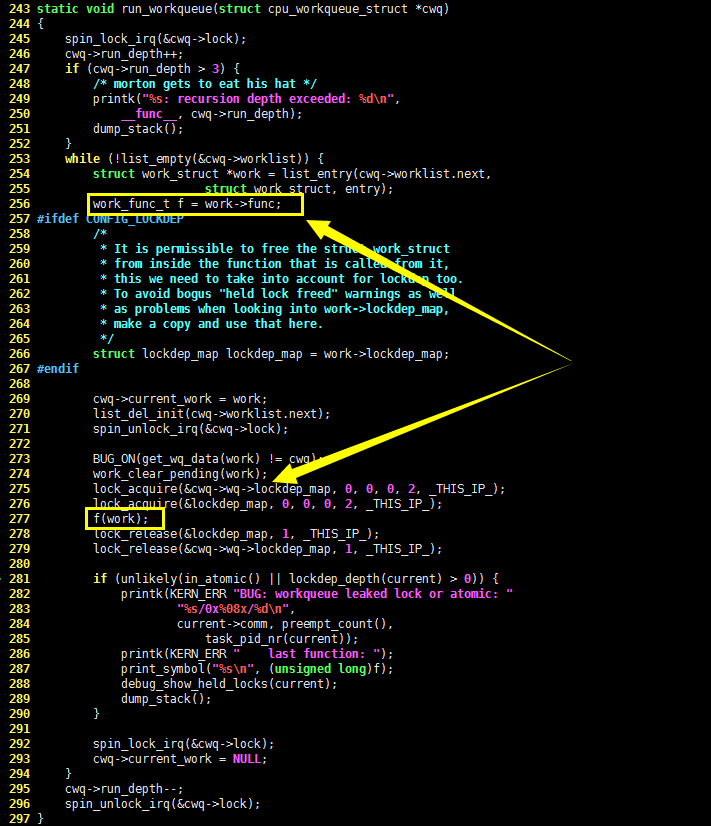
使用工作队列
Linux 内核定义了 DECLARE_WORK 宏用于静态创建 work_struct 结构体,它的C语言代码如下,请看:
#define DECLARE_WORK(n, f) \
struct work_struct n = __WORK_INITIALIZER(n, f)
#define __WORK_INITIALIZER(n, f) { \
.data = WORK_DATA_INIT(), \
.entry = { &(n).entry, &(n).entry }, \
.func = (f), \
__WORK_INIT_LOCKDEP_MAP(#n, &(n)) \
}
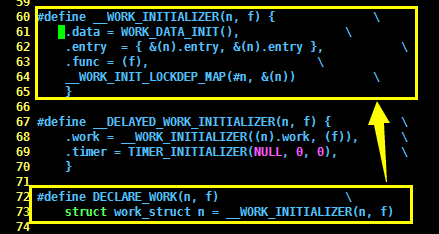
#define INIT_WORK(_work, _func) \
do { \
(_work)->data = (atomic_long_t) WORK_DATA_INIT(); \
INIT_LIST_HEAD(&(_work)->entry); \
PREPARE_WORK((_work), (_func)); \
} while (0)
再来看看工作队列的处理函数,它的原型如下:
void work_handler(void *data);
这个函数由工作者线程执行,因此运行在进程上下文中,允许响应中断,且可以睡眠可以被调度。工作就创建好之后,可以通过 schedule_work() 函数将其交给默认工作线程处理,它的C语言代码如下,请看:
int schedule_work(struct work_struct *work)
{
return queue_work(keventd_wq, work);
}
容易看出, schedule_work() 函数其实就是把 work 加入到全局工作队列 keventd_wq 中,这一动作由 queue_work() 函数完成,它的C语言代码如下:
int queue_work(struct workqueue_struct *wq, struct work_struct *work)
{
int ret = 0;
if (!test_and_set_bit(WORK_STRUCT_PENDING, work_data_bits(work))) {
BUG_ON(!list_empty(&work->entry));
__queue_work(wq_per_cpu(wq, get_cpu()), work);
put_cpu();
ret = 1;
}
return ret;
}
容易看出,queue_work() 函数的核心功能由
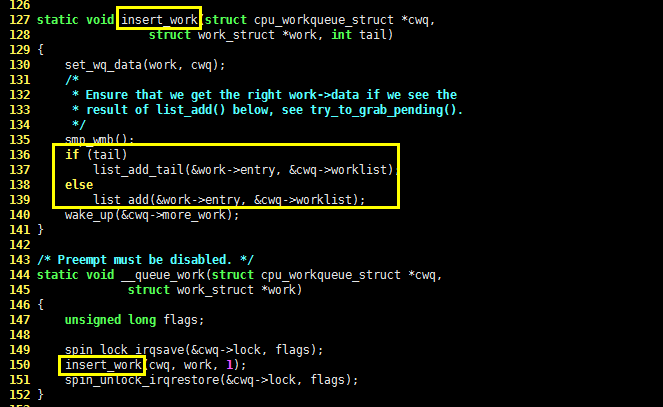
当然,Linux 内核也允许创建新的工作者线程,但是并不推荐,所以相关分析留给读者自己了。
小节
到这里,Linux 内核中关于中断“下半部”的三种类型就粗略的分析完了。“软中断”适合处理对实时性要求高,需要频繁执行的工作,但是需确保共享数据的同步安全性。tasklet 能确保同一类型的工作不会在多个处理器上同时运行,但是它是基于“软中断”实现的,因此和“软中断”一样处于中断上下文中,不能睡眠不能阻塞。如果推后执行的工作需要在进程上下文中运行,则应选择工作队列。